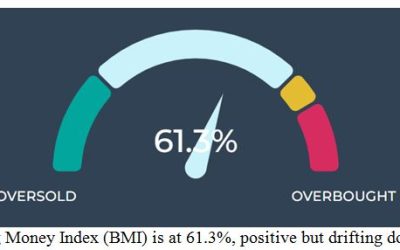by Louis Navellier
September 16, 2025
Producer prices in America are flat to down. That’s largely because China’s National Bureau of Statistics announced last Wednesday that its producer price index declined 2.9% in August compared to the same month a year ago, and we still import a large amount of our wholesale goods from China. China’s August price decline was an improvement over July’s 3.6% annual pace, but China has been in the midst of a deflationary spiral since May of 2022, and that will continue to exert a downward pull on U.S. prices.
Graphs are for illustrative and discussion purposes only. Please read important disclosures at the end of this commentary.
Furthermore, China’s consumer price index (CPI, blue line above) declined 0.4% in August compared to the same month a year ago. August was the biggest CPI decline in China since February, so with deflation evident at both the wholesale and consumer levels, China’s deflationary economic tailspin persists!
Reflecting these global deflationary trends, the Department of Labor announced last Wednesday that America’s Producer Price Index declined 0.1% in August, and July was revised down to a 0.7% increase. In the past 12 months, the PPI has risen 2.6%, substantially below economists’ consensus estimate of a 3.3% increase and well below the 3.1% 12-month decline reported last month, for July. The PPI has now been negative for three of the seven monthly reports released during the Trump 2.0 Administration.
Excluding food and energy, the core PPI also declined by 0.1% in August. That was far below the economists’ consensus estimate of a 0.3% increase. Wholesale energy costs declined by 0.4%. Taking out energy, food and trade services, “core” wholesale goods prices rose by 0.3% in August. Wholesale service costs declined by 0.2% – a pleasant surprise, and Treasury yields declined in the wake of this PPI report.
Then on Thursday, the Department of Labor announced that the Consumer Price Index (CPI) rose 0.4% in August, higher than the economists’ expectations of 0.3%. In the past 12 months, the CPI rose 2.9%, in line with economists’ consensus expectations. The core CPI, excluding food and energy, rose 0.3% in August and 3.1% in the past 12 months. Food prices rose 0.5% and energy prices rose 0.7% in August.
Gasoline prices rose 1.9% in August, but they are expected to decline in the fall, as seasonal demand ebbs. Also, used vehicle prices rose 1% in August, while new car prices rose 0.3%. Overall, this was not an ideal CPI report, which seemed to argue for only a key interest rate cut of 0.25% (not 0.50%) tomorrow.
However, an added piece of news last Thursday increased the likelihood of a 50 basis-point rate cut, as weekly unemployment claims surged by 27,000 to 263,000, reaching the highest rate since October 2021. Economists were actually expecting weekly jobless claims to decline slightly, to 235,000. Instead, the four-week average of weekly jobless claims rose to 240,500, which marked the highest level since June.
Speaking of labor market concerns, the Labor Department announced on Tuesday that it had overstated payroll jobs by 911,000 in the 12 months through last March, the largest such revision in 26 years! This whopping revision represents 0.6% of all payroll jobs and is literally triple the 0.2% average annual revision in the past 10 years. Interestingly, Bloomberg reported that a third of leadership jobs at the Labor Department are vacant, hinting that there may be a morale problem the new commissioner must address.
In other labor news, the recent ICE raid on LG Energy Solutions’ new battery plant in Georgia is sending some shock-waves out, since many worker visas had apparently expired. Before these ICE raids, South Korean companies had been struggling to get work visas. In battery plants, one official said engineers who have expertise in production line design are “irreplaceable.” It will be interesting to see how this visa spat will be resolved. I suspect the Trump Administration will demand more U.S. workers be hired.
France and Britain are Near “Imploding”
Over Rising Debts (and Weak Demographics)
As expected, the French government officially collapsed, as members of Parliament ousted Prime Minister Francois Bayrous in a no confidence vote. French President Emmanuel Macron will nominate a new Prime Minister. Bayrous was demanding $52 billion in annual spending cuts to get France’s budget deficit down to 4.6% of GDP. Bayrous also demanded that Parliament (1) cancel two public holidays, (2) freeze pension and welfare payments at 2025 levels, and (3) levy a new tax on high-income residents.
French President Macron does not have the authority to control Parliament’s budget resolutions and is effectively a lame duck, with very little influence in a minority party. The French Parliament is controlled by Marine Le Pen’s National Party. Complicating matters further, the French statistics agency Insee reported that industrial production declined 1.1% in July, due largely to a 16% drop in aircraft orders.
France may be the first European country to implode from aging demographics and a failure to assimilate its immigrants, and Britain may be the next European country to implode due to its debt crisis, caused by capital flight, aging demographics and being overrun by immigrants that largely fail to assimilate.
The Wall Street Journal reported that “Britain and France aren’t illiquid. They’re insolvent. Their future spending commitments, primarily in the form of expected social welfare and old age benefit payouts, far exceed any realistic estimate of the economic growth that will be available to pay those bills. This is unlikely to induce a true default crisis in either country since a market will always exist for their debt.”
The WSJ concluded by saying, “This misfortune already is causing debt service costs to escalate and is imposing political strains elsewhere in their budgets. Painful belt-tightening eventually will be necessary.”
The easiest way to put a Band-Aid on the growing debt crisis that Britain, France and other countries face is to dramatically lower interest rates to try to reduce the burden of existing debt service. Japan provides a template of how a country must lower rates when government debt becomes unsustainable. China now has lower interest rates than Japan and may have to devalue its currency as demographics take a toll.
As a result, I still expect a global interest rate collapse, with the dominos in Europe being the next to fall.
EV Mandates Are Also Crippling Europe’s Economy
SEC Chairman Paul Atkins is calling out Europe for requiring U.S. companies stationed on the Continent to report on sustainability and climate issues. Specifically, Atkins called these “political fads,” adding that, “Those sorts of principals coming could undermine the integrity of IFRS” (International Financial Reporting Standards) “and particularly its compatibility with (U.S. accounting standards).”
Speaking of climate goals, BMW’s Chief Technology Officer, Joachim Post, is joining Mercedes CEO Ola Källenius in calling for the EU to drop its 2035 EV mandate – a requirement that 100% of vehicles be electric by 2035. Post argued that the EV decision ultimately comes down to buyers, not the European Union (EU), saying “the customer decides.” Last March, the EU reaffirmed its 2035 EV mandate, but as industry calls for changing the electric-only mandate escalate, it will be interesting to see if the EU will destroy the European auto industry, which cannot effectively compete with Chinese EVs these days.
When the $7,500 EV tax credits expire at the end of September, EV sales are expected to slow, so GM is already curtailing its EV production, despite surprisingly strong EV sales. The Trump Administration’s EPA rollback of emission standards is also expected to provide GM, Ford and Stellantis with a windfall, since they will no longer have to buy emission credits from Tesla and Rivian. GM has spent $3.5 billion on regulatory emission credits since 2022, and Ford will save almost $1.5 billion on such credits this year.
While the Big 3 are getting a windfall from the Trump Administration, they also face higher operating costs, due largely to tariffs on Canadian auto parts. GM’s Chief Financial Officer Paul Jacobson said that eliminating the fines “will save us money in 2026 and beyond for sure.” Ford’s Chief Executive Officer Jim Farley told analysts that the shift in policy “has the potential to unlock a multibillion-dollar opportunity over the next two years.” The bottom line is that the Big 3 makes a lot of money on trucks, not EVs, and now they will no longer have to buy regulatory emission credits to comply with the EPA.
Navellier & Associates; do not own General Motors (GM), Ford (F), Rivian (RIVN), or Stellantis (STLA). A few accounts own Tesla (TSLA), per client request. Louis Navellier does not own General Motors (GM), Ford (F), Tesla (TSLA), Rivian (RIVN), or Stellantis (STLA), personally.
The post 9-16-25: Continuing Deflation Could Fuel a 0.5% Fed Rate Cut Tomorrow appeared first on Navellier.






